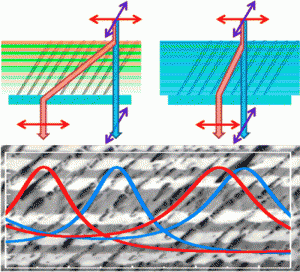Manuel Oliva-Ramirez, Angel Barranco, Markus Löffler, Francisco Yubero, Agustin R. González-Elipe
ACS Nano, 10 (2016) 1256
doi: 10.1021/acsnano.5b06625
Bragg microcavities (BMs) formed by the successive stacking of nanocolumnar porous SiO2 and TiO2 layers with slanted, zigzag, chiral, and vertical configurations are prepared by physical vapor deposition at oblique angles while azimuthally varying the substrate orientation during the multilayer growth. The slanted and zigzag BMs act as wavelength-selective optical retarders when they are illuminated with linearly polarized light, while no polarization dependence is observed for the chiral and vertical cavities. This distinct optical behavior is attributed to a self-nanostructuration mechanism involving a fence-bundling association of nanocolumns as observed by focused ion beam scanning electron microscopy in the slanted and zigzag microcavities. The outstanding retarder response of the optically active BMs can be effectively modulated by dynamic infiltration of nano- and mesopores with liquids of different refraction indices acting as a switch of the polarization behavior. The unprecedented polarization and tunable optofluidic properties of these nanostructured photonic systems have been successfully simulated with a simple model that assumes a certain birefringence for the individual stacked layers and accounts for the light interference phenomena developed in the BMs. The possibilities of this type of self-arranged nanostructured and optically active BMs for liquid sensing and monitoring applications are discussed.


